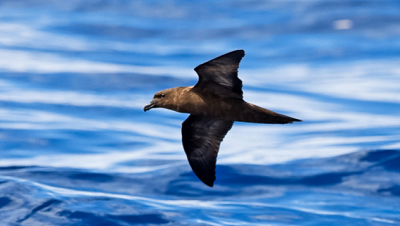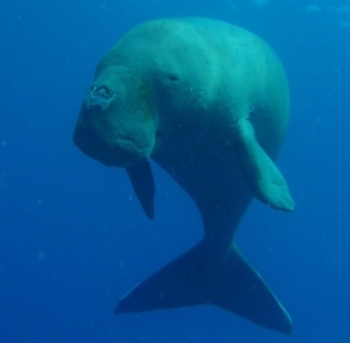
ON THIS PAGE
Introduction
Threatened and migratory marine species are the iconic often beloved or revered species that have provided generations of Pacific Islanders with inspiration and are embedded in culture, stories, and as totems. The Pacific Islands region supports over 33 species of whales and dolphins - 40% of the worlds known species of cetacea, six of seven marine turtles, many sharks and ray species, and 40 species of breeding seabirds with a further 60 recorded in the region. Terrestrial migratory species include shorebirds, and fruit bats which are also an important source of nutrition and provide important ecosystem services.
Migratory species are highly threatened. There are some major success stories such as the stopping of whaling in the southern oceans and global high seas, and the recovery of the southern ocean’s humpback whales. There are also many more species where populations are declining. The “State of the Environment and Conservation in the Pacific Islands” 2020 Regional Report states that population sizes are decreasing for half of the listed Convention on Migratory Species (CMS) in the Pacific, noting that trends are only known for 19% of all listed species. Listed species do not include fruit bats and bats generally are highly threatened in the Pacific region with 38 threatened bat species (18% of the world’s species). Seabirds too are threatened with 11 of the 40 breeding species threatened with extinction, but knowledge of the location, distribution and populations of many remain unknown.
One of the regions most threatened and unique marine species is the Dugong, although not migratory it makes sense to include it among the iconic marine species of the region. It occurs in just five Pacific islands – those being Palau, Papua New Guinea, Solomon Islands, Vanuatu, and New Caledonia - although substantial populations also occur in Australia. The only relative of the dugong, the Steller’s sea-cow, was hunted to extinction in the eighteenth century. Dugong are also disappearing from their current range and could face similar consequences in the future due to loss of seagrass beds, interaction with power vessels and continued hunting and bycatch.
What does SPREP do?
SPREP seeks to provide advice and support to Pacific island countries relating to these species. Migratory species require a strategic environmental approach as they don’t respect national boundaries and migrate sometimes thousands of miles across our blue Pacific and beyond from breeding grounds to foraging grounds annually. If we want to enhance and protect these populations, we must protect them across their whole range from a variety of threats. To do this we must act collectively and collaboratively. SPREP has attempted to provide strategic guidance for the migratory marine species, including Dugong, in the Regional Marine Species Programme and Action Plans.
Visit SPREP's Virtual Library for resources and publications relating to Threatened and Migratory Species.

Marine species projects:
- Regional Marine Species Programme
- Turtle Research and Monitoring Database System (TREDS)
- Strandings of Oceania Database for whales, dolphins and dugongs
- Bycatch and Integrated Ecosystem Management Initiative
Related work:
- Whales in a changing ocean conference 2017
- Dugong and seagrass conservation workshop 2018
- Protect Pacific Whales campaign
- CMS Cetacean MOU
- CMS Dugong MOU
Related news:
- New report highlights recommendations for strengthening the management and conservation of sea turtles in Vanuatu
- Lui Bell Memorial Scholarship supports study on the impact of traditional hunting on Solomon Island dolphin populations
- New report highlights fisheries by-catch as the main threat to whales and dolphins in the Pacific islands region
- A new fishery threatens Papua New Guinea's shark and dolphin species
- Leaders from the Pacific region make a clear statement that the conservation of our oceans is not optional
- Malekula's marine turtle community conservation
- Marine species highlighted at CITES COP19
- Saving vulnerable inshore dolphins in southern Papua New Guinea
- The Pacific-European Union Marine Partnership Programme By-catch and Integrated Ecosystem Management Initiative supports marine turtle genetics capacity building among Pacific researchers via online workshop series
- First dedicated seabird surveys for Samoa
- Sixteen year journey of green turtle highlights value of SPREP's Turtle Research and Monitoring Database System
- New plan to conserve and manage marine species in the Pacific launched
- Upgraded regional database set to serve turtle conservation and management needs in the Pacific Ocean
- Celebrating innovations in turtle conservation research
- Protecting our turtles, now and into the future
- Turtle tagging and release success at Salelesi in Samoa
- Protecting Vanuatu's marine species
- Fourth meeting of the Pacific Cetacean MOU convenes virtually
- Working together to protect marine species in the Pacific
- Protecting our sharks
- Marine turtle extinction risk assessment to support decision making in turtle conservation
- Hot sands and endangered species - field notes from Tonga
- Supporting the conservation of endangered marine species in the Solomon Islands
Contact us
Karen Baird (Threatened and Migratory Species Advisor).